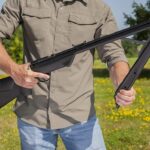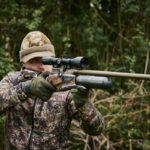It’s a question those of us in the gun writing business often get asked. “What’s the best caliber for a self-defense handgun?” Those expecting a one-to-three digit answer from me will be disappointed. I respond to their simple question with a complex one. “What is the most powerful cartridge that you can shoot accurately and proficiently that comes in a handgun which is comfortable enough to carry that you’ll carry it all the time?” Depending on the person asking, the answer will vary. For some, it’s a full-sized .357 Mag. or 10 mm Auto. For others, it’s one of the current .380 ACPs offered in a 9 mm-sized handgun. And in certain cases, it’s the .22 LR.
When many law-enforcement agencies transitioned from .40 S&W to 9 mm Luger, internet forums exploded with discussions of how this proved that the 9 mm was “just as good,” ballistically, as the .40 S&W. No, the .40 S&W has a larger diameter and heavier bullet moving at higher velocities. It’s simple physics. But law-enforcement agencies are choosing their go-to caliber on the basis of many factors, ballistics being just one of those. They also look at ammunition costs, service life of firearms, and the ability of their trainees to become proficient and accurate relatively quickly. For these reasons, the 9 mm is starting to win out.
Civilians who carry a firearm for self-defense are considering many of the same factors, including ammunition cost and availability, but their most important consideration should be using a firearm that is reliable and that they can consistently hit their target with at self-defense distances. Ballistic advantages goes out the window when your bullet doesn’t connect. Five .22 LRs in the bullseye beat one .44 Mag. that missed completely. To paraphrase famed lawman Bill Jordan, ballistics are fine, but accuracy is final.
Recoil is one factor that can hamper accuracy. Even cartridges on the lower end of the power spectrum, like the .380 ACP, can produce a lot of recoil when paired with one of today’s ultralight, micro-compact handguns. Lack of recoil is the .22 LR’s main advantage when it comes to shooting accurately. The topic of the .22 LR as a self-defense cartridge has been fought over and over in digital and print forums.
This article is not an argument that the .22 LR is “the best” round for self-defense, or even a good choice for many firearms owners who can use a more powerful cartridge. But the .22 LR may be the best option for certain shooters, as a primary or back-up firearm, and if this is the case, they need to choose the best ammunition and firearm for the job. To that end, in a two-part series, we will review both ammunition (Federal Punch .22 LR and Winchester Silvertip .22 LR) and a firearm (Smith & Wesson Model 43C) specifically designed for self-defense with the .22 LR cartridge.
 This year two manufacturers, Winchester and Federal, introduced .22 LR cartridges designed specifically for self-defense, the Silvertip (left) and Premium Punch (right).
This year two manufacturers, Winchester and Federal, introduced .22 LR cartridges designed specifically for self-defense, the Silvertip (left) and Premium Punch (right).
The .22 rimfire cartridges has a long history as a self-defense round. The cartridge was introduced by Smith & Wesson in 1857, when they chambered their first revolver, the Model 1, in the tiny rimfire. The petite handgun was not a military or law enforcement firearm. It was designed for civilian self-defense. The seven self-contained .22 rimfire rounds its cylinder held could be rapidly loaded, offering a distinct firepower advantage over the single-shot pistol or five and six-shot blackpowder revolvers of the day, whose ball, powder and primers had to be loaded separately. While the ballistics of the .22 Short (as it later became known) blackpowder cartridge were pretty poor (it launched its 29-grain bullets at just over 800 f.p.s. for an energy yield of about 44 ft.-lbs.) it was a close-range weapon of last resort.
Over the years, the .22 rimfire grew in performance. A “Long” version was introduced in 1871, followed by a “Long Rifle” cartridge in 1884. The Long Rifle (“LR”) .22 rimfire round, the most common today, effectively tripled the power of the original .22 Short. As self-contained ammunition advanced, more powerful rounds were developed that had the .22 rimfire’s quick loading advantages, but the .22 LR remained a popular choice for self-defense. A wide-range of small and affordable handguns were available in the caliber and in many rural homesteads, a .22-cal. rifle served triple duty by putting meat on the table, eliminating varmints and dissuading two-legged predators.
The .22 LR has found modern military and law-enforcement applications, especially where noise or over penetration are a consideration. The quietness of the round when suppressed meant it was used by intelligence agencies, like the U.S. Office of Strategic Services (OSS) and British Special Operations Executive (SOE) during World War II. Long-range U.S. bomber crews in the same conflict were issued Stevens 22-410 rifle and shotgun combination guns as survival weapons. Full metal jacketed ammunition was supplied to the flyers, just in case they had to use the .22 LR for defensive purposes.
Military and law enforcement use of .22 LRs continued after the war. U-2 pilots carried a suppressed High Standard .22-cal. pistol. In the 1970s, the British Army issued .22-cal. Walther PPs (designated the L66A1) to their soldiers in Northern Ireland for self-defense while off-duty. The Israelis have used the .22 LR in several law enforcement and military applications. Their air marshals famously carried Beretta Model 71s in .22 LR and successfully used them in several incidents against heavily-armed terrorists attempting to hijack an airliner. The Israelis also modified a version of the ArmaLite AR-7 survival rifle into a “personal defense weapon” for their F4 Phantom pilots.
 The .22 LR rimfire cartridge was often used by military and law enforcement, such as this Walther PP, used by off-duty British soldiers in Northern Ireland and designated in the service as the L66A1.
The .22 LR rimfire cartridge was often used by military and law enforcement, such as this Walther PP, used by off-duty British soldiers in Northern Ireland and designated in the service as the L66A1.
While technological advances creep forward in the firearms field, one of the biggest revolutions in the past two decades was in ammunition. Modern advances in powder and bullet designs have turned formally “obsolete” or “inadequate” cartridges, like the .32 S&W or the .32 ACP, into viable options for self-defense. The .22 Winchester Magnum has recently been given serious self-defense consideration, with several manufacturers developing a load for the rimfire cartridge for their premium self-defense lines.
In 2021, two ammunition manufacturers, Federal and Winchester, introduced a .22 LR cartridge specifically designed for self-defense applications. These two cartridges take different approaches to how they are designed to work. The Federal Punch .22 LR is designed to meet the FBI standard of 12″ of penetration in ballistic gelatin from the short barrel length of common concealed carry handguns.
Instead of the standard .22 rimfire lubricated lead bullet, the 29-grain bullet in the Punch cartridge has a nickel jacket over its lead core and has a flat-nose bullet profile. The Winchester Silvertip .22 LR uses a plated segmented hollow-point bullet that weighs 37 grains. The bullet is designed to break into four pieces upon impact, the three “petals” of the bullet creating an initial wound canal, while the base continues to penetrate.
 The two .22 LR rounds introduced for self-defense take different design approaches. The Federal Punch .22 (left) uses a flat-nose bullet design with a full nickel plating designed for maximum penetration. The Winchester Silvertip .22 LR (right) uses a plated segmented hollow point, the “petals” of which create an initial wound canal while the base continues to penetrate.
The two .22 LR rounds introduced for self-defense take different design approaches. The Federal Punch .22 (left) uses a flat-nose bullet design with a full nickel plating designed for maximum penetration. The Winchester Silvertip .22 LR (right) uses a plated segmented hollow point, the “petals” of which create an initial wound canal while the base continues to penetrate.
 The Federal Premium Punch .22 LR was designed for penetration. In factory testing, the bullet penetrated 13.75″ in 10 percent ballistic gelatin. Photo courtesy of Federal Ammunition.
The Federal Premium Punch .22 LR was designed for penetration. In factory testing, the bullet penetrated 13.75″ in 10 percent ballistic gelatin. Photo courtesy of Federal Ammunition.
Both cartridges are optimized to perform with the velocity generated by a short barrel. Federal claims 1070 f.p.s. out of a 2” barrel, with the 1.875” barrel of the Smith & Wesson Model 43C yielding an average velocity of 1196 f.p.s. for the Punch. The same revolver yielded 1008 f.p.s. from the Silvertip load, just under the factory’s claimed 1080 f.p.s. velocity from a 3.5” barrel. For accuracy testing, the Smith & Wesson Model 43C revolver yielded five-shot groups of just under 2″ at 7 yards with the Punch and just under 1.5″ with the Silvertip.
One of the issues with using the .22 LR for self-defense is reliability. As anyone who uses bulk pack .22 LRs can tell you, you get the occasional failure to fire from rimfire cartridges. Small rimfire cartridges are more fragile-rough handling tends to dent cases, bend bullets or loosen them in their cases. To overcome these weaknesses, Federal claims it rigorously tests and monitors its Punch .22 LR production for reliability.
The cartridge’s case is also nickel plated to prevent corrosion from the handling that defense ammunition gets in repeated loading and unloading and to aid in chambering and extraction. Winchester also claims that the plated bullets in their Silvertips aid in reliability. In the course of our testing, we averaged about one Punch .22 LR that failed to fire, even after multiple firing pin strikes from different handguns, from each 50-round box. The Silvertips had no failures to fire.
 Self-defense handguns in .22 LR vary from purpose-built protection guns to target and plinking firearms that can be pressed into service. Pictured, from left, are the Walther TPH, Glock 44, North American Arms (NAA) 22MC, Smith & Wesson 43C, and Walther P22.
Self-defense handguns in .22 LR vary from purpose-built protection guns to target and plinking firearms that can be pressed into service. Pictured, from left, are the Walther TPH, Glock 44, North American Arms (NAA) 22MC, Smith & Wesson 43C, and Walther P22.
As we will point out in the second article in this series, the revolver has distinctive advantages when using .22 LR for self-defense. However, semi-automatic defensive handguns in .22 LR are are offered and will be popular for some users. To that end, we tested both the Punch and the Silvertip in semi-automatic handguns.
Both cartridges functioned reliably in the models we tried them in, even a Glock 44, a firearm which our earlier evaluation showed to be finicky with cartridges that used bullets weighing less than 40 grains. Semi-automatic handguns in .22 LR tend to be picky about what they eat, and this is especially true for compact ones, so anyone wanting to use the .22 LR for self-defense in a semi-automatic handgun should thoroughly test their ammunition of choice for reliability.
How does the ballistic performance of a .22 LR stack up against other popular defense calibers in the short barrel lengths of the firearms people typically carry? We compare the ballistic performance of popular handguns and cartridges in the chart below. Note, in particular, the .22 WMR. Originally intended as a varmint round, the magnum .22 delivers over twice the muzzle energy of a .22 LR from a rifle-length barrel. As barrel length decreases, however, so does the magnum’s advantage. From a two-inch barrel the velocity difference between a Long Rifle and .22 Mag., both loaded with 40-gr. bullets, is about 100 f.p.s. or 14 ft.-lbs. of energy.

What about recoil? It’s very difficult to quantify how a shooter perceives a firearm’s recoil. Factors like the height of the bore above the frame, grip angle and size along with frame material can make the same amount of recoil feel very different in other firearms of the same caliber and weight. To attempt to compare how a .22 LR firearm stacks up against other defensive cartridges on paper, we used calculated free recoil.
This takes into account the weight of the firearm, the weight of the bullet and powder charge in its cartridge and the velocity the bullet is launched at. Using those factors, we compared free recoil based on the following popular self-defense firearm and cartridge combinations:

So how do these numbers on paper translate into the “real world?” To visually quantify and compare energy and recoil we set up a non-scientific water jug test comparing the two .22 LR self-defense loads to other common self-defense ammunition and firearms. Water jugs in no way duplicate ballistic gelatin, nor were we trying to mimic the factory testing of these cartridges, but they do give us a visual “apples-to-apples” comparison of the striking force and penetration of the different types of ammunition, as well as a medium in which to trap the fired bullet.
The jugs were positioned 5 yards away from the muzzle of the firearm. We first tested velocity at this distance to establish the exact force the bullets would be striking with. Then we recorded both the reaction of the water jugs when struck and recoil of the handguns at the moment of firing against a reference grid and these are compared in the accompanying video at the top of this article.
The Punch .22 LR showcased the penetration it was designed for. It went through three jugs, coming to rest in the fourth. Its bullet stayed intact and showed no damage, save for the imprint of the rifling. The Silvertip .22 LR also performed exactly as advertised. The hollow point segmented in the first jug, with two of the three petals staying in the jug and one exiting out the side. The base of the bullet, which weighs approximately 26-gr., continued into the third jug where it stopped.
 As part of our evaluation, we did an informal ballistics test comparing the striking power and penetration of the new .22 LR cartridges versus other common self-defense cartridges in short-barreled handguns using water-filled jugs.
As part of our evaluation, we did an informal ballistics test comparing the striking power and penetration of the new .22 LR cartridges versus other common self-defense cartridges in short-barreled handguns using water-filled jugs.
The remaining rounds, the .22 WMR Hornady Critical Defense and the Federal Punch .380 ACP, 9 mm Luger and .38 Spl., all stopped in the third jug with their bullets expanding as advertised. The fact that all of these cartridges exhibited nearly the same penetration is a testament to the perfection that self-defense bullet design has obtained. But the same penetration doesn’t mean the same performance. The difference in recoil and striking energy between the cartridges is easily apparent in our video. Bigger bullets equal more energy, but that horsepower comes at a cost on the back-end in terms of recoil.
So if you’re going with a rimfire for self-defense, are specialty rounds worth the extra cost? As a control, we fired a Federal Champion .22 WMR into the jug test. Its 40-gr. .FMJ bullet zipped through five jugs and kept on going into the backstop, with the exit hole of the final jug showing little expansion. Self-defense ammo is engineered with a singular purpose and its performance advantages are even more critical if you’re using rimfire cartridges, which are already on the lower end of the performance scale, for personal protection.
The advantages of the .22 LR for self-defense come down to two factors: recoil and ammunition cost. The lack of recoil, noise and over-pressure from the .22 LR cartridge, even from a compact handgun, is an advantage for shooters who are recoil sensitive due to age, injury or inexperience. It also makes recovery and follow-up shots quicker and easier.
If accuracy is final, then practice makes perfect. The MSRP for 50 rounds of Punch .22 is $10.99. As a comparison, Federal Premium’s .38 Spl. +P Punch loading has an MSRP of $26.99 for a box of 20. Winchester’s Silvertip .22 LR retails for $9.99 for a box of 50, compared to $25.99/20 rounds for the company’s Silvertip .38 Spl. load. [Note: “MSRP” means “Manufacturer’s Suggested Retail Price” – not what you can actually find this ammunition for on the shelves of your local gun shop these days]. Not only are premium .22 self-defense rounds cheaper than their centerfire counterparts, .22 LR target ammunition represents an even bigger cost savings. This makes it much more affordable to get in the practice necessary for one to become proficient with their firearm.
While the .22 LR cartridge might not be the best ballistic option for self-defense, modern ammunition, like the Federal Punch and Winchester Silvertip, makes it a more viable option for those for whom the .22 rimfire is the best choice.















































